Determination of Optimal Technological Parameters for Sorting Wheat Grains in Chambers of Different Constructions
Abstract
1. Introduction
2. Materials and Methods
2.1. Determination of Aerodynamic Properties of Wheat Grains
2.2. Determination of Wheat Grain Flow in Sorting Chambers of Different Cross-Sections
2.3. Statistical Analysis
3. Results
3.1. Aerodynamic Properties of Wheat Grains
3.2. Wheat Grain Flow in Sorting Chambers of Different Cross-Sections
4. Discussion
5. Conclusions
Author Contributions
Funding
Data Availability Statement
Conflicts of Interest
References
- Tibola, C.S.; Fernandes, J.M.C.; Guarienti, E.M. Effect of cleaning, sorting, and milling processes in wheat mycotoxin content. Food Control 2016, 60, 174–179. [Google Scholar] [CrossRef]
- Konopka, S.; Choszcz, D.; Wierzbicki, K. Wpływ wilgotności mieszaniny na skuteczność procesu rozdziału gryki od zanieczyszczeń w obrotowym sicie szczelinowym (The effect of the moisture content of a seed mixture on the separation efficiency of buckwheat seeds and impurities in a rotary groove separator). Inżynieria Rol. 2000, 9, 119–125. [Google Scholar]
- Xiao, Y.; Wang, H.; Shao, X. 2D numerical modeling of grain-sorting processes and grain size distributions. J. Hydro-Environ. Res. 2014, 8, 452–458. [Google Scholar] [CrossRef]
- Choszcz, J.; Reszczynski, P.S.; Kolankowska, E.; Konopka, S.; Lipinski, A. The Effect of Selected Factors on Separation Efficiency in a Pneumatic Conical Separator. Sustainability 2020, 12, 3051. [Google Scholar] [CrossRef]
- Bulgakov, V.; Nikolaenko, S.; Holovach, I.; Adamchuk, V.; Kiurchev, S.; Ivanovs, S.; Olt, J. Theory of grain mixture particle motion during aspiration separation. Agron. Res. 2020, 18, 8–37. [Google Scholar] [CrossRef]
- Bazaluk, O.; Postnikova, M.; Halko, S.; Mikhailov, E.; Kovalov, O.; Suprun, O.; Miroshnyk, O.; Nitsenko, V. Improving Energy Efficiency of Grain Cleaning Technology. Appl. Sci. 2022, 12, 5190. [Google Scholar] [CrossRef]
- Astanakulov, K.D.; Karimov, M.R.; Khudaev, I.; Israilova, D.A.; Muradimova, F.B. The separation of light impurities of safflower seeds in the cyclone of the grain cleaning machine. IOP Conf. Ser. Earth Environ. Sci. 2020, 614, 012141. [Google Scholar] [CrossRef]
- Vaiciukevičius, E.; Strakšas, A. Investigation of biometric parameters and aerodynamic properties of buckwheat. Lith. Agric. Univ. Res. Pap. 2009, 83, 92–97. [Google Scholar]
- Gupta, R.K.; Arora, G.; Sharma, R. Aerodynamic properties of sunflower seed (Helianthus annuus L.). J. Food Eng. 2007, 79, 899–904. [Google Scholar] [CrossRef]
- Giyevskiy, A.M.; Orobinsky, V.I.; Tarasenko, A.P.; Chernyshov, A.V.; Kurilov, D.O. Substantiation of basic scheme of grain cleaning machine for preparation of agricultural crops seeds. IOP Conf. Ser. Mater. Sci. Eng. 2018, 327, 042035. [Google Scholar] [CrossRef]
- Mokhtari Nahal, A.; Arabhosseini, A.; Kianmehr, M.H. Separation of shelled walnut particles using pneumatic method. Int. J. Agric. Biol. Eng. 2013, 6, 88–93. [Google Scholar]
- Srivastava, K.; Carroll, E.; Roger, G.; Rohrbach, P.; Buckmaster, R.D. Grain Harvesting. Chapter 12 in Engineering Principles of Agricultural Machines, 2nd ed.; Asabe: St. Joseph, MI, USA, 2006; pp. 403–435. [Google Scholar]
- Aliev, E.B.; Shevchenko, I.A. Investigation of Aerodynamic Properties of Oilseeds. Bull. Agrar. Sci. (Bicник Aгpаpнoї Науки) 2017, 3, 63–65. [Google Scholar]
- Stepanenko, S. Research pneumatic gravity separation grain materials. Mech. Agric. 2017, 63, 54–56. [Google Scholar]
- Shrestha, K.P.; Parajuli, P.; Baral, B.; Shrestha, B.P. Mathematical modeling, simulation and analysis of rice grain movement for design and fabrication of low-cost winnowing machine. J. Mech. Eng. Res. 2017, 9, 012041. [Google Scholar] [CrossRef]
- Panasiewicz, M.; Sobczak, P.; Mazur, J.; Zawiślak, K.; Andrejko, D. The technique and analysis of the process of separation and cleaning grain materials. J. Food Eng. 2012, 109, 603–608. [Google Scholar] [CrossRef]
- Chernyakov, A.V.; Koval, V.S.; Yatsunov, A.N.; Begunov, M.A.; Shevchenko, A.P.; Evchenko, A.V. Research of a conical pneumatic grain separator with a device for forced light fraction removal. IOP Conf. Ser. Earth Environ. Sci. 2021, 659, 012041. [Google Scholar] [CrossRef]
- Kılıçkan, A.; Güner, M. Pneumatic Conveying Characteristics of Cotton Seeds. Biosyst. Eng. 2006, 95, 537–546. [Google Scholar] [CrossRef]
- Kumar, S.; Singh, S.; Vishwakarma, R.K.; Singh, B.R. Evaluating the effects of some relevant parameters on physicomechanical and aerodynamic properties of sunflower seed. New Agric. 2019, 30, 1–8. [Google Scholar]
- Aliev, E.; Pryshliak, V.; Yaropud, V. Research of physical and mechanical properties of oilseed crops. Motrol. Comm. Mot. Energetics Agric. 2017, 19, 103–108. [Google Scholar]
- Qing, T.; Chongyou, W.; Suzhen, W.; Chengwen, Z.; Yongfei, S. Research advances and prospects in cleaning device of grain. Agric. Mech. Res. 2013, 12, 225–228. [Google Scholar]
- Adamchuk, V.; Bulgakov, V.; Ivanovs, S.; Holovach, I.; Ihnatiev, Y. Theoretical study of pneumatic separation of grain mixtures in vortex flow. Eng. Rural. Dev. 2021, 20, 657–667. [Google Scholar]
- Saitov, V.E.; Kurbanova, R.F.; Suvorov, A.N. Assessing the Adequacy of Mathematical Models of Light Impurity Fractionation in Sedimentary Chambers of Grain Cleaning Machines. Procedia Eng. 2016, 150, 107–110. [Google Scholar] [CrossRef][Green Version]
- Paun, A.; Stroescu, G.; Zaica, A.; Ştefan, V.; Olan, M.; Yasbeck Khozamy, S. Obtaining “organic seeds” of vegetable and industrial plants using the aerodynamic properties of the seeds. Inmateh-Agric. Eng. 2021, 63, 355–364. [Google Scholar] [CrossRef]
- Hu, Z.; Zeng, H.; Ge, Y.; Wang, W.; Wang, J. Simulation and Experiment of Gas-Solid Flow in a Safflower Sorting Device Based on the CFD-DEM Coupling Method. Processes 2021, 9, 1239. [Google Scholar] [CrossRef]
- Jasinskas, A.; Zvicevičius, E. Biomasės Gamybos Inžinerija (Biomass Production Engineering); IDP Soliutions: Akademija, Lithuania, 2008; Volume 44, (In Lithuanian with English Summary). [Google Scholar]
- Moskovskiy, M.N. Synthesis of System Solutions for the Technological Process of Obtaining Seeds on the Basis of Structural-Functional Modeling. Ph.D. Thesis, Kuban State Agrarian University, Krasnodar, Russia, 2017; p. 491. [Google Scholar]
- Khamuev, V.; Gerasimenko, S.; Chaava, M. Engineering design of technological parameters of separation of seed in the upward air flow of pneumatic sorting machines. E3S Web Conf. 2019, 126, 00030. [Google Scholar] [CrossRef]
- Ni, K.; Du, X.; Chen, S.; Chen, J.; Zhao, Y. Study on Grain Distribution in a Cross-flow Grain Separation Chamber Based on the Discrete Element Method. In Proceedings of the 2013 ASABE Annual International Meeting Sponsored by ASABE, Kansas City, MI, USA, 21–24 July 2013. [Google Scholar]
- Jasinskas, A.; Steponavičius, D.; Šarauskis, E.; Šniauka, P.; Vaiciukevičius, E.; Zinkevičius, R. Agricultural Machinery Laboratory Works; Lithuania Agricultural University: Akademija, Lithuania, 2010; Volume 110. [Google Scholar]
- Vaiciukevičius, E.; Šarauskis, E.; Jasinskas, A.; Sakalauskas, A.; Butkus, V.; Strakšas, A. Consistent patterns of detail movement in variable free air flow. J. Food Agric. Environ. 2010, 8, 370–374. [Google Scholar]
- Witte, R.S.; Witte, J.S. Statistics; John Wiley & Sons: Hoboken, NJ, USA, 2017. [Google Scholar]
- Vaiciukevičius, E.; Domeika, R.; Šarauskis, E.; Jasinskas, A.; Jasevičius, P.; Romaneckas, K. Research of pea seed sorting in the sloping air flow. Actual Tasks Agric. Eng. 2020, 48, 1–8. [Google Scholar]
- Stepanenko, S.; Kotov, B.; Kuzmych, A.; Shvydia, V.; Kalinichenko, R.; Kharchenko, S.; Shchur, T.; Kocira, S.; Kwasniewski, D.; Dziki, D. To the Theory of Grain Motion in an Uneven Air Flow in a Vertical Pneumatic Separation Channel with an Annular Cross Section. Processes 2022, 10, 1929. [Google Scholar] [CrossRef]
- Zewdu, A.D. Aerodynamic properties of the grain and straw material. Biosyst. Eng. 2007, 46, 304–309. [Google Scholar] [CrossRef]
- Zhao, L.; Chen, l.; Yuan, F.; Wang, L. Simulation Study of Rice Cleaning Based on DEM-CFD Coupling Method. Processes 2022, 10, 281. [Google Scholar] [CrossRef]
- Hharchenko, S.; Borshch, Y.; Kovalyshyn, S.; Piven, M.; Abduev, M.; Miernik, A.; Popardowski, E.; Kielbasa, P. Modeling of Aerodynamic Separation of Preliminarily Stratified Grain Mixture in Vertical Pneumatic Separation Duct. Appl. Sci. 2021, 11, 4383. [Google Scholar] [CrossRef]
- Khamyev, V.; Gulyev, A.; Boiko, A. Justification of the design of pneumatic sorting machine for the preparation of selection seeds. In Proceedings of the International Conference on Modern Trends in Manufacturing Technologies and Equipment, Sevastopol, Russian, 30 October 2018; Volume 224, p. 05008. [Google Scholar] [CrossRef][Green Version]
- Nadimi, M.; Hawley, E.; Liu, J.; Hildebrand, K.; Sopiwnyk, E.; Paliwal, J. Enhancing traceability of wheat quality through the supply chain. Compr. Rev. Food Sci. Food Saf. 2023, 22, 2495–2595. [Google Scholar] [CrossRef] [PubMed]
- Mykhailov, Y.; Zadosna, N.; Postnikova, M.; Pedchenko, G.; Khmelovskyi, V.; Bondar, M.; Ionichev, A.; Kozdęba, M.; Tomaszewska-Górecka, W. Energy assessment of the pneumatic sieve separator for agricultural crops. Agric. Eng. 2021, 25, 147–155. [Google Scholar] [CrossRef]
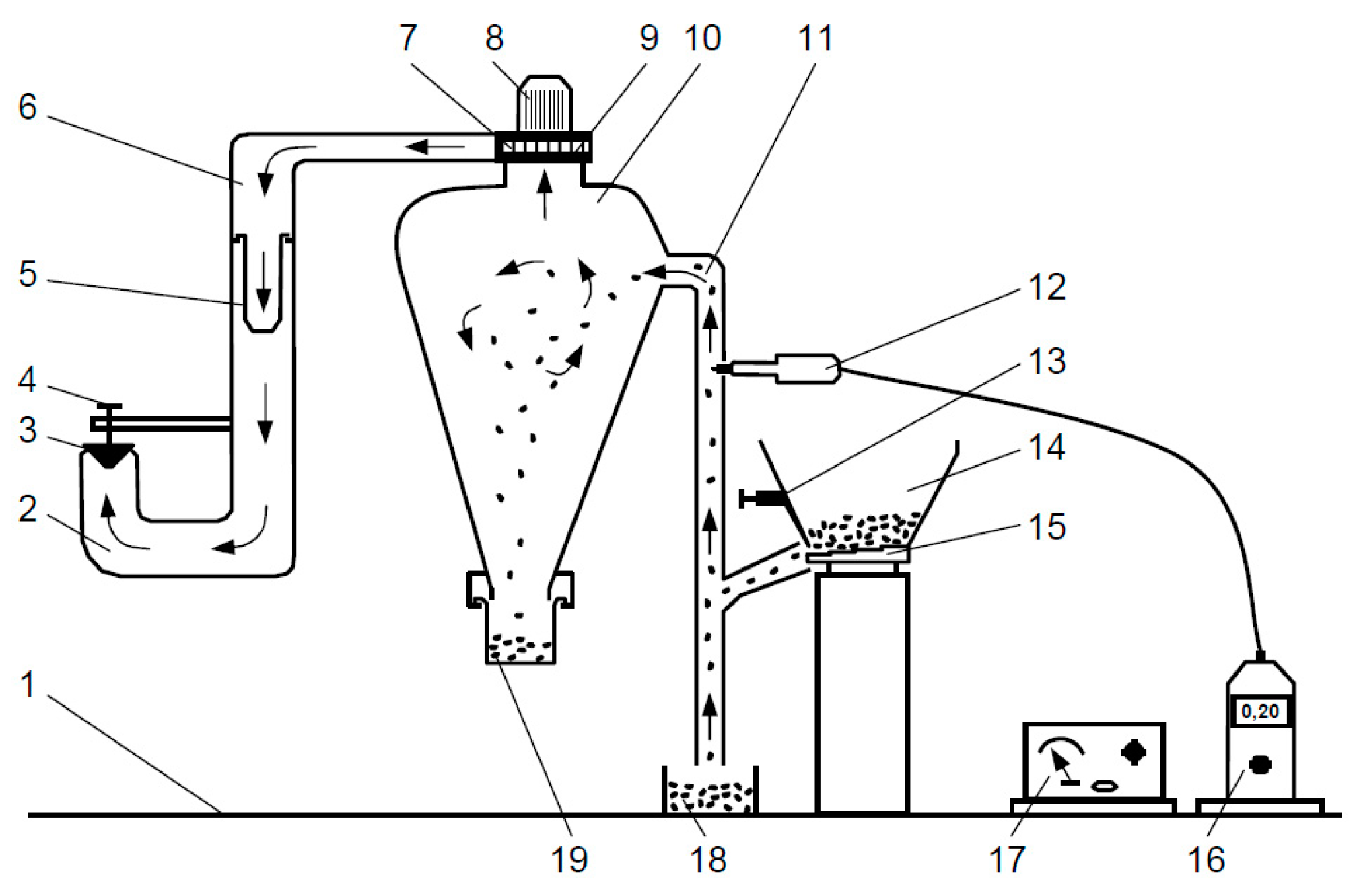

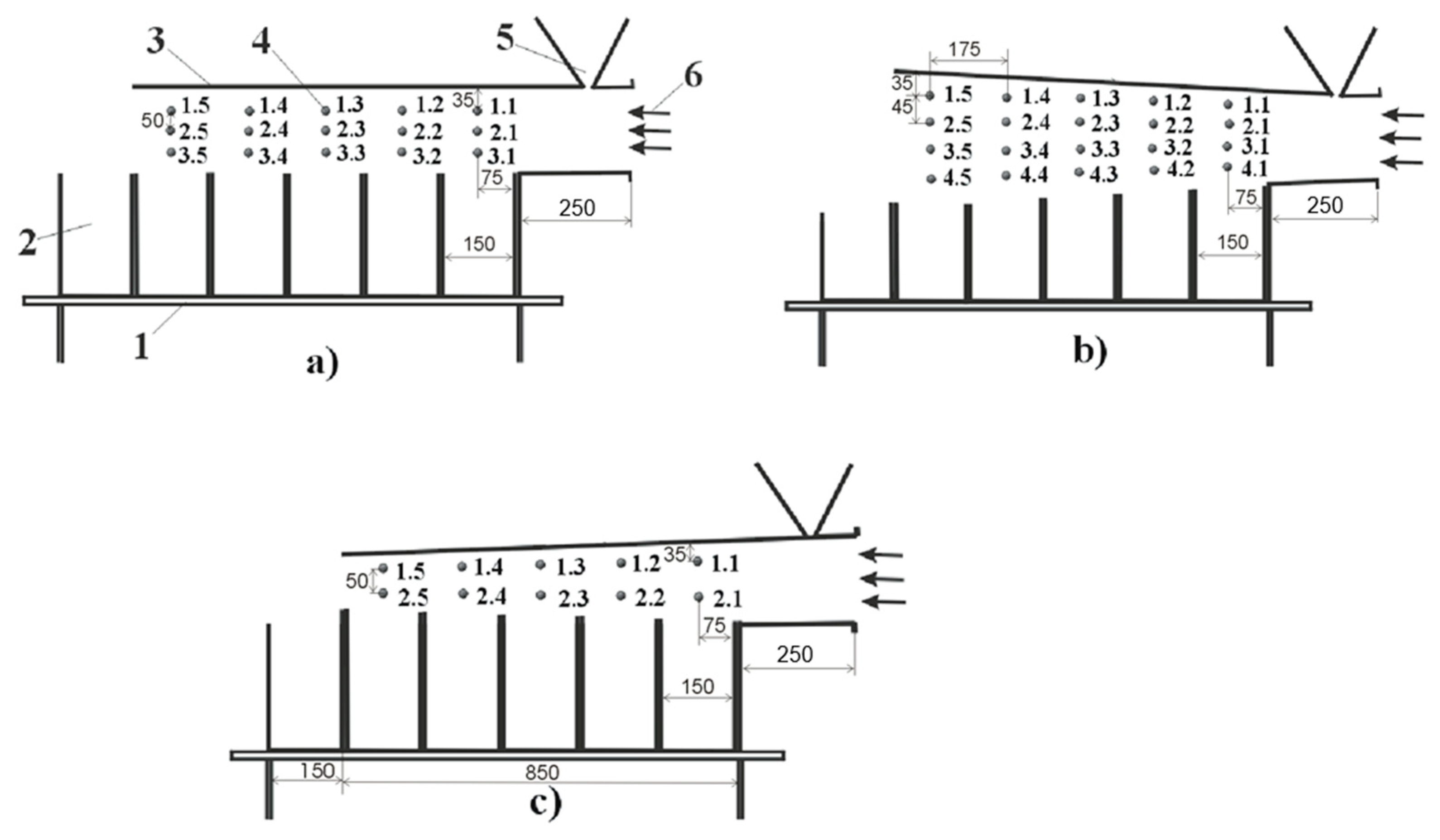
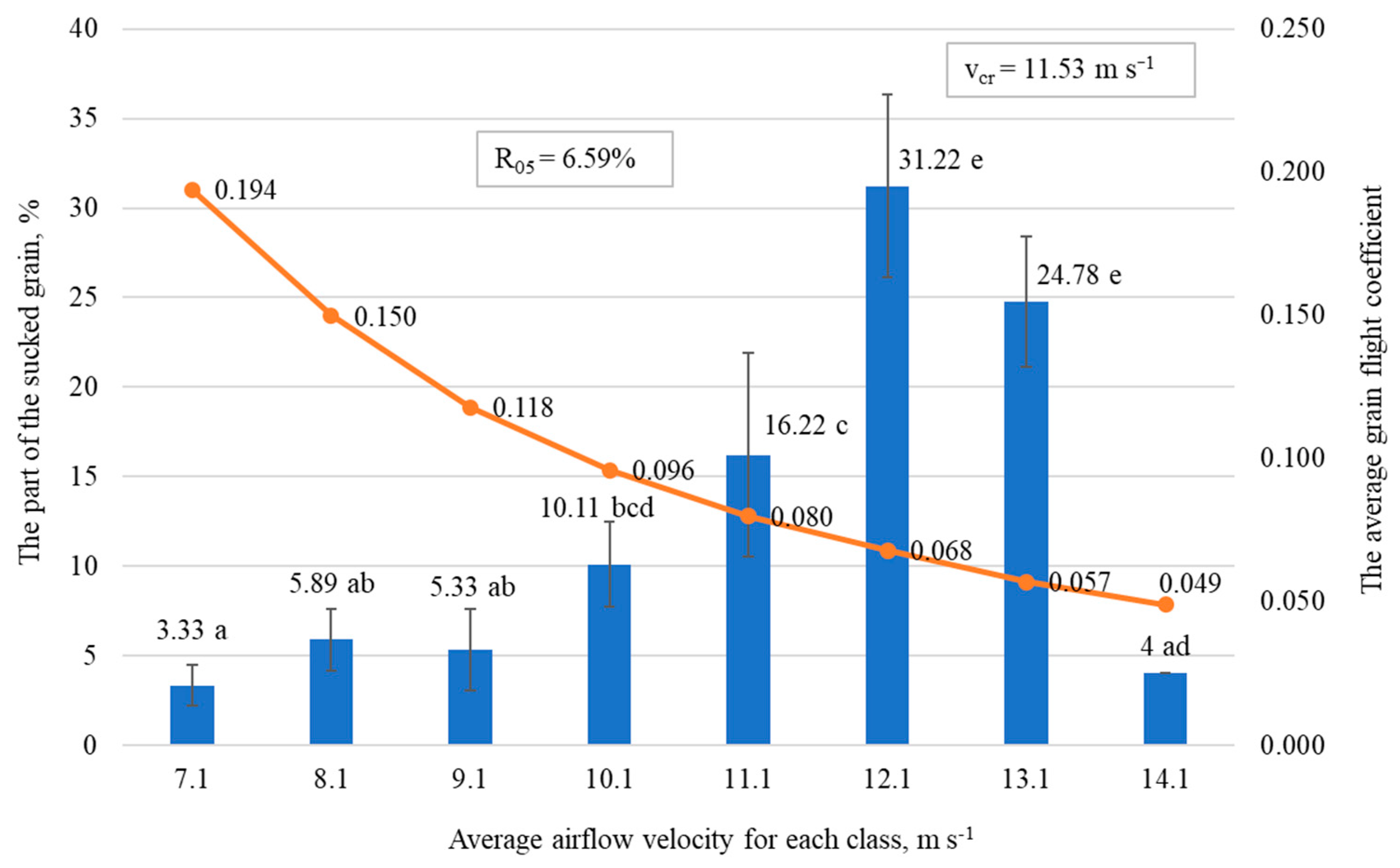
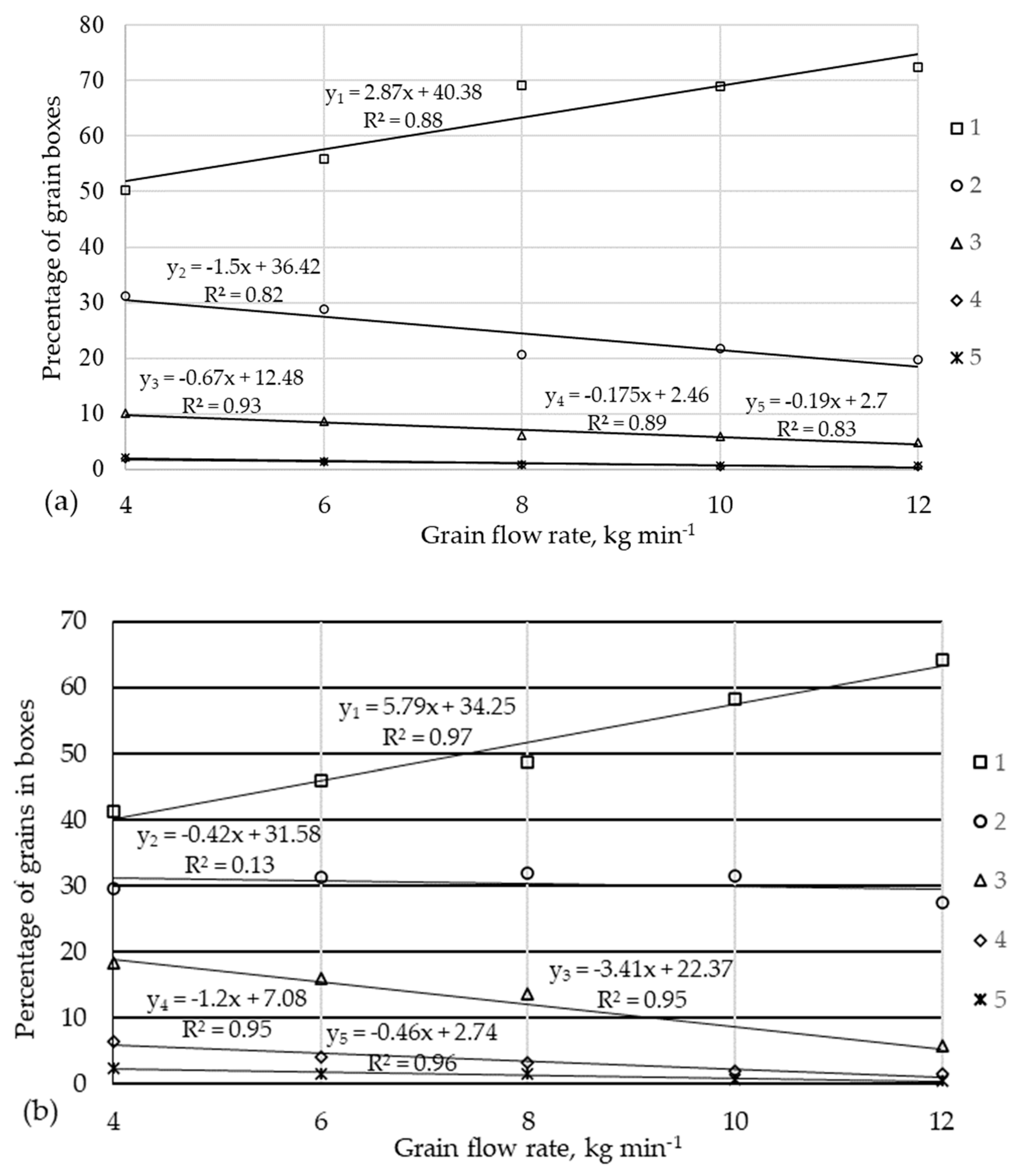
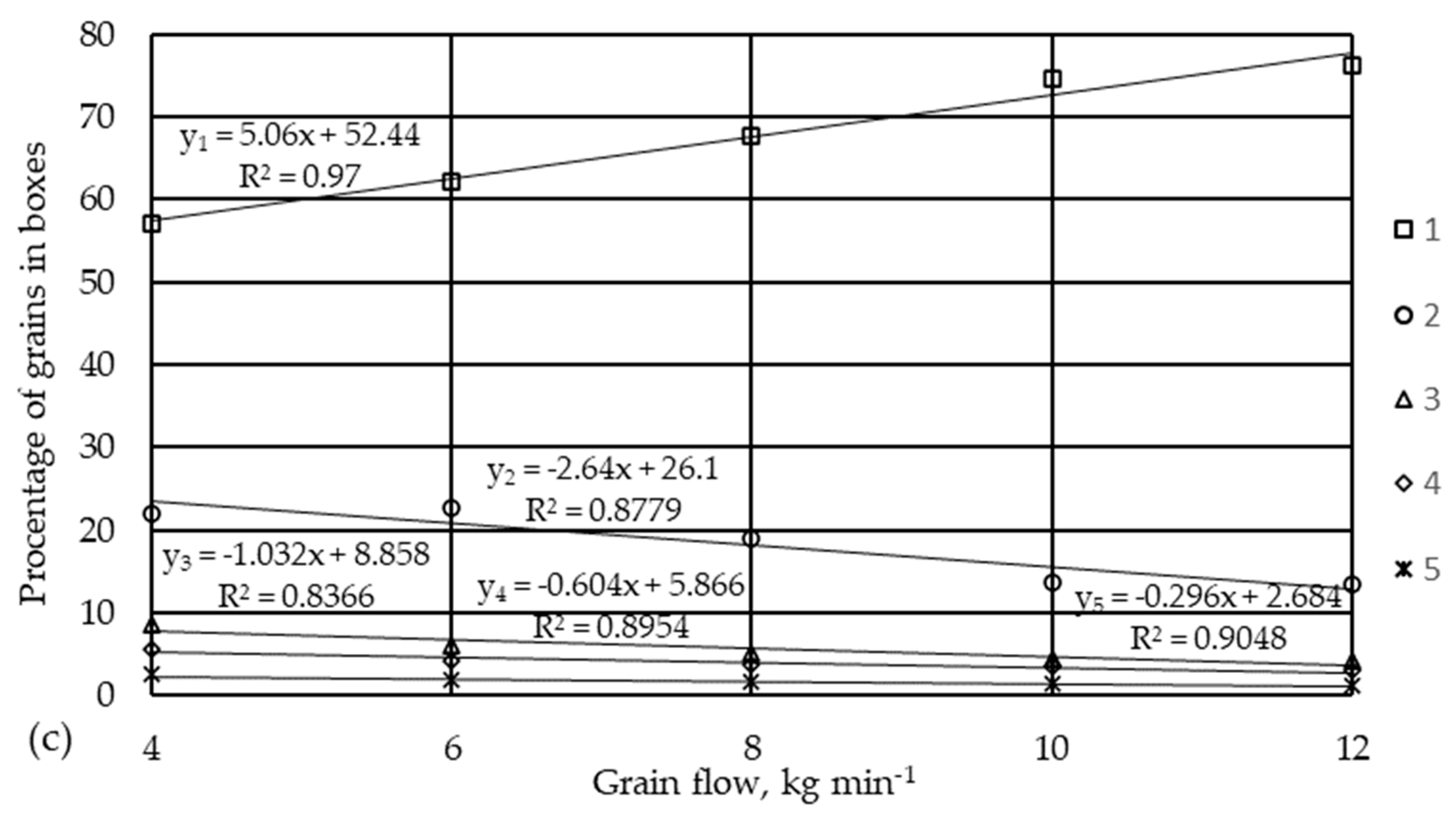
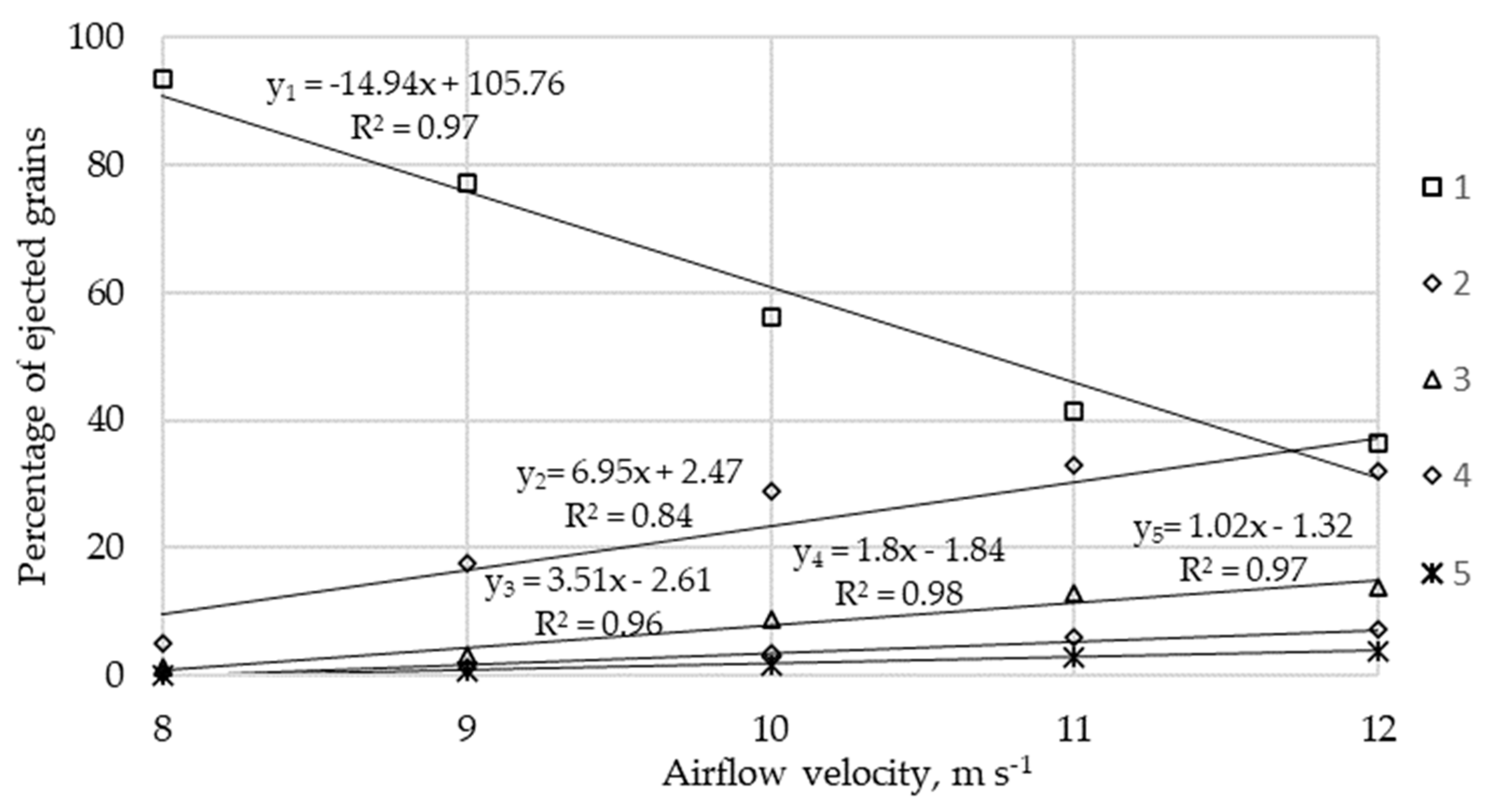

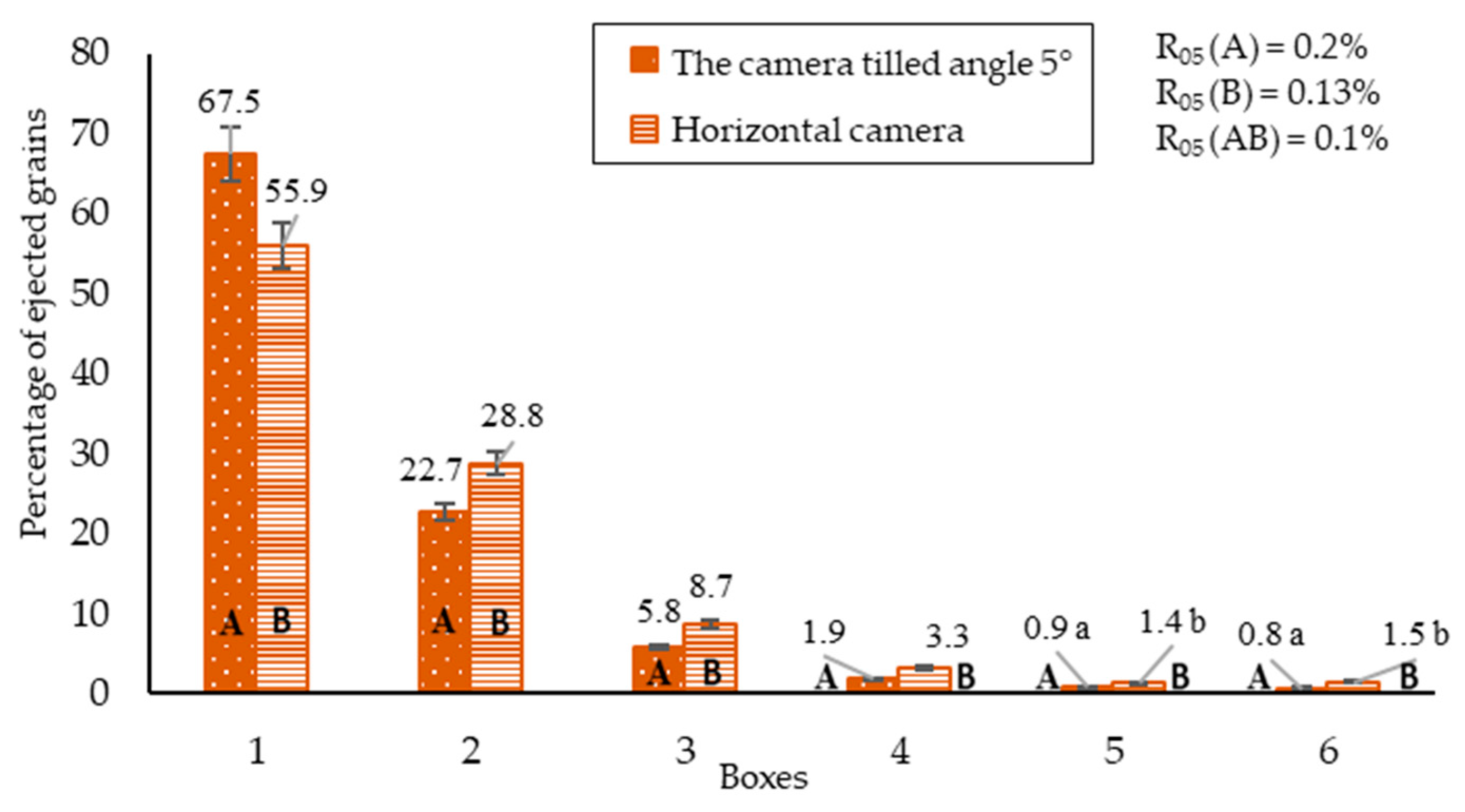

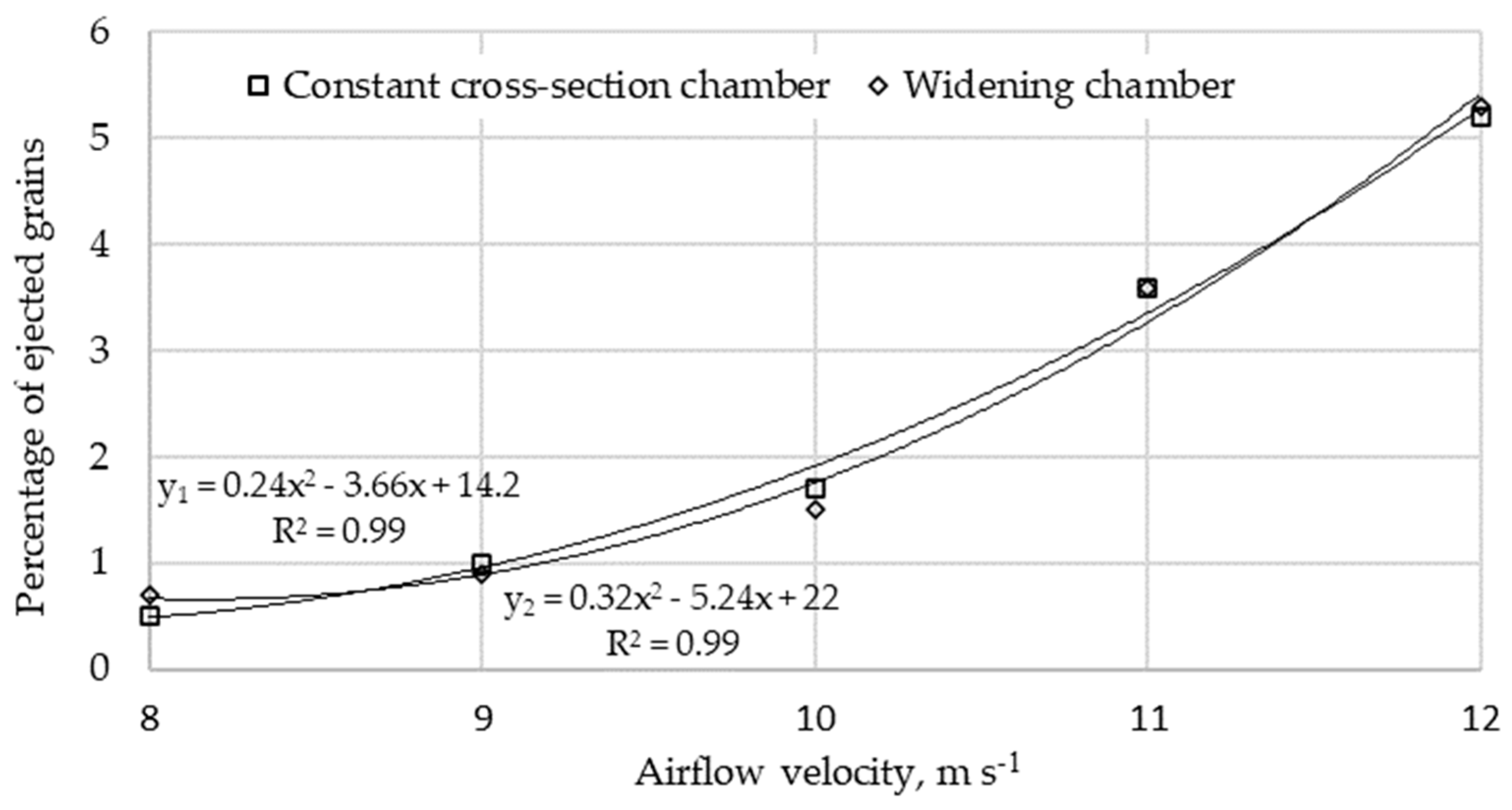
| Measurement of Airflow Velocity in a Grain Sorting Chamber of Constant Cross-Section | |||||
| Measurement points | 1.1 | 1.2 | 1.3 | 1.4 | 1.5 |
| Airflow velocity, m s−1 | 10 | 10 | 9.8 | 8.9 | 8.6 |
| Measurement points | 2.1 | 2.2 | 2.3 | 2.4 | 2.5 |
| Airflow velocity, m s−1 | 10 | 9.9 | 9.8 | 9.7 | 9.5 |
| Measurement points | 3.1 | 3.2 | 3.3 | 3.4 | 3.5 |
| Airflow velocity, m s−1 | 10 | 9.7 | 9.7 | 9.5 | 9.4 |
| Measurement of Airflow Velocity in a Grain Sorting Chamber of Widening Cross-Section | |||||
| Measurement points | 1.1 | 1.2 | 1.3 | 1.4 | 1.5 |
| Airflow velocity, m s−1 | 8.8 | 8 | 7.9 | 7.7 | 7.5 |
| Measurement points | 2.1 | 2.2 | 2.3 | 2.4 | 2.5 |
| Airflow velocity, m s−1 | 9.9 | 9.4 | 8.9 | 8.3 | 7.8 |
| Measurement points | 3.1 | 3.2 | 3.3 | 3.4 | 3.5 |
| Airflow velocity, m s−1 | 10 | 9.9 | 9.6 | 8.8 | 7.7 |
| Measurement points | 4.1 | 4.2 | 4.3 | 4.4 | 4.5 |
| Airflow velocity, m s−1 | 9.9 | 8.9 | 8.4 | 7.7 | 7.3 |
| Measurement of Airflow Velocity in a Grain Sorting Chamber of Narrowing Cross-Section | |||||
| Measurement points | 1.1 | 1.2 | 1.3 | 1.4 | 1.5 |
| Airflow velocity, m s−1 | 10.2 | 10.3 | 10.3 | 10.2 | 10.3 |
| Measurement points | 2.1 | 2.2 | 2.3 | 2.4 | 2.5 |
| Airflow velocity, m s−1 | 10 | 9.9 | 10.2 | - | - |
Disclaimer/Publisher’s Note: The statements, opinions and data contained in all publications are solely those of the individual author(s) and contributor(s) and not of MDPI and/or the editor(s). MDPI and/or the editor(s) disclaim responsibility for any injury to people or property resulting from any ideas, methods, instructions or products referred to in the content. |
© 2023 by the authors. Licensee MDPI, Basel, Switzerland. This article is an open access article distributed under the terms and conditions of the Creative Commons Attribution (CC BY) license (https://creativecommons.org/licenses/by/4.0/).
Share and Cite
Vaiciukevičius, E.; Jasinskas, A.; Jotautienė, E.; Domeika, R.; Gerdauskas, K.; Zinkevičienė, R.; Lekavičienė, K. Determination of Optimal Technological Parameters for Sorting Wheat Grains in Chambers of Different Constructions. Processes 2023, 11, 3441. https://doi.org/10.3390/pr11123441
Vaiciukevičius E, Jasinskas A, Jotautienė E, Domeika R, Gerdauskas K, Zinkevičienė R, Lekavičienė K. Determination of Optimal Technological Parameters for Sorting Wheat Grains in Chambers of Different Constructions. Processes. 2023; 11(12):3441. https://doi.org/10.3390/pr11123441
Chicago/Turabian StyleVaiciukevičius, Edvardas, Algirdas Jasinskas, Eglė Jotautienė, Rolandas Domeika, Kasparas Gerdauskas, Raimonda Zinkevičienė, and Kristina Lekavičienė. 2023. "Determination of Optimal Technological Parameters for Sorting Wheat Grains in Chambers of Different Constructions" Processes 11, no. 12: 3441. https://doi.org/10.3390/pr11123441
APA StyleVaiciukevičius, E., Jasinskas, A., Jotautienė, E., Domeika, R., Gerdauskas, K., Zinkevičienė, R., & Lekavičienė, K. (2023). Determination of Optimal Technological Parameters for Sorting Wheat Grains in Chambers of Different Constructions. Processes, 11(12), 3441. https://doi.org/10.3390/pr11123441










